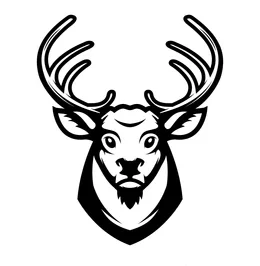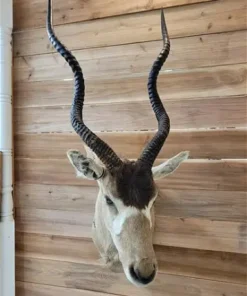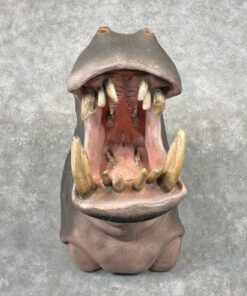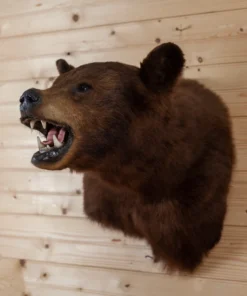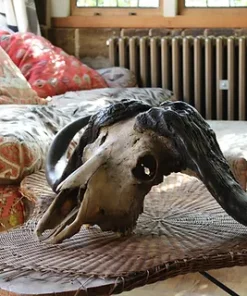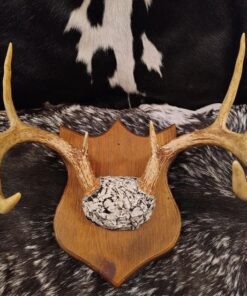Head mounts Taxidermy
Head mounts in taxidermy are a popular way to preserve and display the head and sometimes the shoulders of an animal in a lifelike pose. This type of mount focuses on showcasing the animal’s head, antlers, or horns, and can be a striking addition to any collection or display. Here’s an in-depth look at head mounts in taxidermy:
1. Purpose and Uses
**a. Decorative Display
- Personal Collections: Many people use head mounts as trophies or personal collections, showcasing their hunting achievements or appreciation for wildlife.
- Interior Design: Head mounts can serve as unique and eye-catching decor elements in homes, offices, or public spaces.
**b. Educational and Historical
- Museums: Used for educational displays to teach about wildlife, anatomy, and conservation.
- Historical Significance: Often used in historical contexts to represent animal species and their roles in ecosystems or human culture.
2. The Process of Creating a Head Mount
**a. Preparation
- Specimen Selection: Choose a high-quality specimen with a well-preserved head. The condition of the hide, horns, or antlers can affect the final result.
- Pose and Position: Decide on the pose and expression of the mount. This will guide the entire mounting process and ensure the final product looks natural and lifelike.
**b. Skinning and Preservation
- Skinning: The head is skinned carefully, typically from the base of the skull down to just below the shoulders. The skin must be removed with precision to avoid damaging it.
- Preservation: The skin is treated with preservatives to prevent decay. This may include salting, pickling, or using specialized taxidermy solutions.
**c. Creating the Form
- Form Construction: A foam or other material form is sculpted to replicate the animal’s head and shoulders. The form must match the animal’s anatomy closely to ensure a realistic appearance.
- Customization: Details such as muscle structure, skin folds, and specific features (like antlers or horns) are crafted to fit the form accurately.
**d. Mounting the Head
- Fitting the Skin: The preserved skin is carefully fitted onto the form. This involves adjusting and aligning the skin to ensure it fits snugly and looks natural.
- Detailing: Special attention is given to facial features, such as the eyes, nose, and mouth, to achieve a lifelike expression. Antlers or horns are attached securely and positioned as desired.
**e. Finishing Touches
- Eyes and Ears: Realistic eyes and ears are often used to enhance the mount’s realism. They are positioned and adjusted to achieve a natural look.
- Painting and Touch-Ups: The mount may be painted or touched up to enhance color and detail, ensuring that it closely resembles the living animal.
3. Display and Maintenance
**a. Mounting
- Installation: Head mounts are typically displayed on walls or mounted on plaques. They may be attached to a base or integrated into a larger display.
- Positioning: Ensure proper lighting and placement to highlight the details of the mount and avoid any distortions in appearance.
**b. Care
- Cleaning: Regular dusting and occasional cleaning with a soft brush or cloth are necessary to keep the mount looking its best.
- Pest Control: Regular inspections for pests, such as beetles or moths, are important. Using pest repellents or treatments can help protect the mount.
- Environmental Factors: Keep the mount away from direct sunlight and excessive moisture to prevent fading and deterioration.
4. Ethical and Legal Considerations
- Legal Compliance: Ensure that the specimen was obtained legally and ethically, with proper permits and adherence to wildlife protection regulations.
- Sustainability: Consider the impact of using wildlife specimens and explore alternatives when possible. Some choose to use animals that have died from natural causes or were part of regulated populations.
5. Applications and Trends
- Custom Orders: Many taxidermists offer custom head mounts, allowing clients to choose specific poses, backgrounds, or additional features.
- Cultural Significance: In some cultures, head mounts have historical or ceremonial importance, reflecting traditional practices and beliefs.
Head mounts in taxidermy offer a detailed and striking way to preserve and display an animal’s head, focusing on the unique characteristics and beauty of the specimen. They require skill and care to create and maintain, ensuring that the final piece is both realistic and respectful of the animal.
Head Mounts
Head Mounts
Head Mounts
Head Mounts
